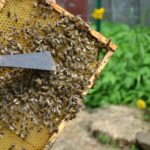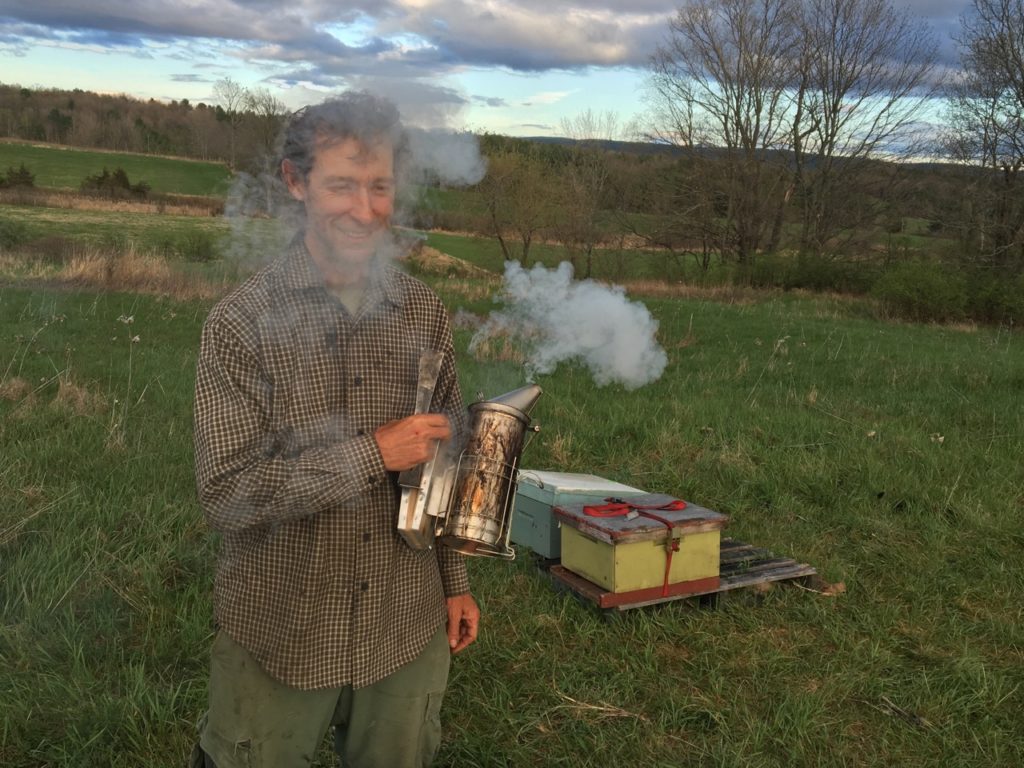Honey bees on the farm will pollinate our flowers. Todd began a relationship with honey bees over 50 years when he and his brother Tom, 9 years old, bought their first hive for their family farm. They were enchanted by how industrious the bees were, giving them honey, pollen, propolis and beeswax for candles and salve. Around 40% of what is eaten is pollinated by insects, this to a great degree by honey bees. Because there are so few nectar & pollen plants on Thornhill Farm, we are planting these plants for the bees. We know the soil is worn out on the farm because our honey bees make so little honey. This is why we have pigs. When the forest is cleared, we do not burn the wood that is left behind, but chip it and mix these wood chips with manure and fungus mycelium to make piles of compost to improve the soil. Last summer we grew peas and oats as a green manure crop, and the pea flowers gave voluminous amounts of nectar to the honey bees and pollinating insects.
Health & the Hive: A Beekeeper’s Journey
 A Jan Cannon Film that explores the importance of honeybees in our lives through the seasons of Honey Gardens Apiaries, Todd and the team. Topics addressed in the film include pollination, queen breeding, disease control, bee venom therapy, organic agriculture and honey-based plant medicine. 53 minute dvd. $10 + $4 (shipping).
A Jan Cannon Film that explores the importance of honeybees in our lives through the seasons of Honey Gardens Apiaries, Todd and the team. Topics addressed in the film include pollination, queen breeding, disease control, bee venom therapy, organic agriculture and honey-based plant medicine. 53 minute dvd. $10 + $4 (shipping).
to order, send a check to: 198 Taylor Road, Greensboro Bend, Vermont 05842
writings & images about the honey bees of Thornhill Farm
- Tim McFarline, McFarline Apiaries, Benson, Vermont June 3, 2016

Tim McFarline, McFarline Apiaries, Benson, Vermont. Tim raises queen bees organically from survivors and sells colonies of bees each Spring. We worked together for six years. May 2016.
Live from the Hive by Annie Watson – Winter 1997 to July 2015 archives
- Live from the Hive: June 2013“Blossoms to Berries” By Annie Watson June is the month when the wild berry plants blossom here in the north country. As I write, blackcaps (aka black raspberries or rubus occidentals) are blooming. This unassuming little flower is a big favorite of honey bees. The first blackberry (rubus alligheniensis) flowers are about to open. When the ...
- Live from the Hive: May 2013“Air Freight!” By Annie Watson For the past two days the bees have been coming in absolutely loaded down with bright yellow willow pollen and grey red maple pollen. I wonder how they can even get airborne, the pollen baskets on their back legs are so encumbered with huge blobs of the stuff. It’s funny to ...
- Live from the Hive: April 2013“Pollen!” By Annie Watson The bees were busy in the warm weather yesterday. The workers came back to the hive looking like they’d spent some time in a bakery — all dusted with very light tan pollen. It could be red maple, or maybe elm — I’m not sure. Red maples bloom around this time. Now, ...
- The Season TurnsWinter shifts into spring with the Spring Equinox on March 20, and with the change comes contrasts in weather. One day it’s 45 degrees and the pussy willows are blooming; the next morning everything is covered with 6 inches of snow. On warm days the bees are flying, looking for the first pollen to feed ...
- The Turning of the YearFrom the cover of an old scrapbook, found at justsomethingimade.com In the old days in many parts of England and Scotland, it was said that honeybees hummed in their hives exactly at midnight on Christmas eve — some even said they sang a Christmas hymn. This belief also existed in France, Belgium, Switzerland, and Germany. (See ...